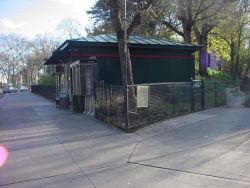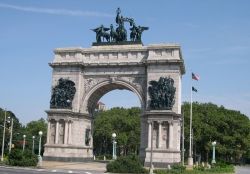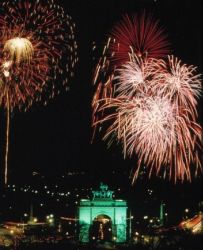Grand Army Plaza
View all monuments in NYC Parks, as well as temporary public art installations on our NYC Public Art Map and Guide.
Bailey Fountain
| Artist: | Eugene F. Savage |
| Dedicated: | 1932 |
| Location: | North side of Grand Army Plaza |
Artwork History
Named after Brooklyn-based financier and philanthropist Frank Bailey (1865-1953) and his wife Mary Louise Bailey, this elaborate sculptural waterwork is one of several which have occupied a central place in Brooklyn’s Grand Army Plaza.
Between 1865 and 1866, British-born architect Calvert Vaux (1824-1895) designed the oval plaza as a transitional element between the confluence of major streets and Prospect Park. He positioned a fountain at its center, which functioned by the early 1870s. The thrilling spectacle of numerous water jets illuminated at night by gas lamps attracted many viewers.
In 1897, five years after the erection in 1892 of the Soldiers and Sailors Memorial Arch in the plaza, the original fountain--eroded and often inoperative--was removed, and a new “electric” fountain designed by F.W. Darlington was installed. However, the replacement fountain was dismantled in 1915 to allow for the construction of the subway lines beneath the plaza.
In the late 1920s, Bailey and his wife gave $125,000 for construction of a new fountain, whose designers, architect Edgerton Swarthout and sculptor Eugene Savage, were selected through a design competition. Work on the fountain began in 1929 and was completed in 1932. The central bronze sculptures include male and female figures atop the prow of a ship, representing Wisdom and Felicity, surrounded by Neptune, his attendant Triton, and a boy holding a cornucopia. The base is made of large stones imbedded in the foundation, and additional decorative elements with sea motifs adorn the pedestal.
Born in Chatham, New York, Frank Bailey graduated from Union College in Schenectady, New York, and served as the college treasurer for 51 years. He began his professional career as a clerk at Title Guarantee and Trust Company, within five years became vice president of its Brooklyn office, and later served as company president until 1924. An avid horticulturalist, Bailey was also chairman of the Brooklyn Botanic Garden, a founder and trustee of the Museum of the City of New York, and a trustee of the Brooklyn Institute of Arts and Sciences. In 1945, he published his autobiography, titled It Can’t Happen Here Again. He died on August 26, 1953 at his country estate in Locust Valley, New York.
The Bailey Fountain, a popular gathering spot and backdrop for wedding photos, was fully rehabilitated in 1956 and again in 2005.
Artwork Details
| Description: | Group of three standing figures (heroic scale) on pedestal adorned with three reclining figures (heroic scale), in basin with rockwork coping |
| Architect: | Edgerton Swarthout; H. Craig Severance (advisor) |
| Materials: | Figures and pedestal--bronze; Basin--stone; Basin coping--aglomerated rocks |
| Dimensions: | H: 25' (approximate) |
| Donor: | Frank and Mary Louise Bailey |
| Cast: | 1931 |
Inscription
1) on pedestal: "Edgerton Swarthout architect / Eugene Savage sculptor / H. Craig Severance architect "2) on pedestal, east side: "To Brooklyn / The Gift / Of Mr And Mrs Frank Bailey / MCMXXXI"
Please note, the NAME field includes a primary designation as well as alternate namingsoften in common or popular usage. The DEDICATED field refers to the most recent dedication, most often, butnot necessarily the original dedication date. If the monument did not have a formal dedication, the yearlisted reflects the date of installation.
For more information, please contact Art & Antiquities at (212) 360-8163.
Check out your park's Vital Signs
Clean & Safe
Green & Resilient
Empowered & Engaged Users
Share your feedback or learn more about how this park is part of a
Vital Park System











